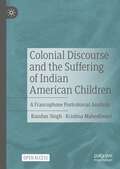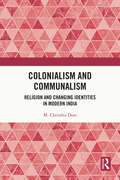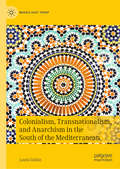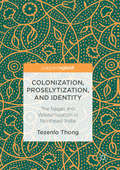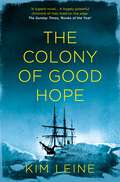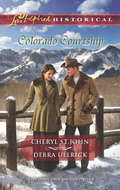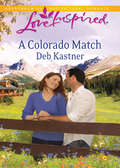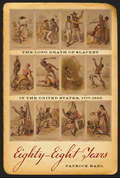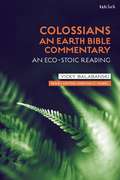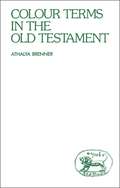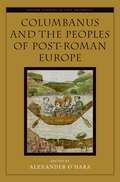- Table View
- List View
Colonial Discourse and the Suffering of Indian American Children: A Francophone Postcolonial Analysis
by Kundan Singh Krishna MaheshwariEuro-American misrepresentations of the non-West in general, and in particular on Hinduism and ancient India, run deep and have far greater colonial connections than that have been exposed in academia. This book analyzes the psycho-social consequences that Indian American children face after they are exposed to the school textbook discourse on Hinduism and ancient India. The authors show that there is an intimate connection—an almost exact correspondence—between James Mill’s colonial-racist discourse and the current school-textbook discourse. The very parameters and coordinates on which James Mill constructed the discourse are the ones that are being used to describe Hinduism, Hindus, and ancient India in the textbooks currently. Consequently, this archaic and racist discourse, camouflaged under the cover of political correctness, produces in the Indian American children a psychological impact quite similar to what racism is known to produce: shame, inferiority, embarrassment, identity confusion, assimilation, and a phenomenon similar to racelessness where the children dissociate from the tradition and culture of their ancestors. This book argues that the current school textbook discourse on Hinduism and India needs to change so that the Indian American children do not become victims of overt and covert racism. For the change to occur, the first step is to recognize the overarching and pervasive influence of the colonial-racist discourse of James Mill on the textbooks. For the reconstruction of the discourse to take place, the first step is to engage in a thorough deconstruction, which is what the book attempts.
Colonial Saints: Discovering the Holy in the Americas, 1500–1800
by Allan Greer Jodi BilinkoffFrom the cult of Saint Anne to the devotees of the Virgin of Guadalupe, from Saint Anthony who competed with Christ for popularity in Brazil, to Jesuits who mixed freely with shamans that talked with the gods, this exciting new anthology examines the conversion of the colonized. The essays examine how New World spirits transformed into Old World saints - for example, the spirit of love transfigured into the Virgin Mary - as well as the implications of the canonization of the first American saint. Colonial Saints illustrates the complex and intimate connections among confessional life writing, canonization, and the practices of the Inquisition. There was a dynamic exchange involving local agendas, the courts in Spain and France, and, of course, Rome. This bold collection clearly shows the interplay between slavery and spirituality, conversion and control, and the links between the sacred and the political.
Colonial Saints: Discovering the Holy in the Americas, 1500–1800
by Allan Greer Jodi BilinkoffFrom the cult of Saint Anne to the devotees of the Virgin of Guadalupe, from Saint Anthony who competed with Christ for popularity in Brazil, to Jesuits who mixed freely with shamans that talked with the gods, this exciting new anthology examines the conversion of the colonized. The essays examine how New World spirits transformed into Old World saints - for example, the spirit of love transfigured into the Virgin Mary - as well as the implications of the canonization of the first American saint. Colonial Saints illustrates the complex and intimate connections among confessional life writing, canonization, and the practices of the Inquisition. There was a dynamic exchange involving local agendas, the courts in Spain and France, and, of course, Rome. This bold collection clearly shows the interplay between slavery and spirituality, conversion and control, and the links between the sacred and the political.
Colonialism and Communalism: Religion and Changing Identities in Modern India
by M. Christhu DossChristhu Doss examines how the colonial construct of communalism through the fault lines of the supposed religious neutrality, the hunger for the bread of life, the establishment of exclusive village settlements for the proselytes, the rhetoric of Victorian morality, the booby-traps of modernity, and the subversion of Indian cultural heritage resulted in a radical reorientation of religious allegiance that eventually created a perpetual detachment between proselytes and the “others.”Exploring the trajectories of communalism, Doss demonstrates how the multicultural Indian society, known widely for its composite culture, and secular convictions were categorized, compartmentalized, and communalized by the racialized religious pretensions. A vital read for historians, political scientists, sociologists, anthropologists, and all those who are interested in religions, cultures, identity politics, and decolonization in modern India.
Colonialism and Communalism: Religion and Changing Identities in Modern India
by M. Christhu DossChristhu Doss examines how the colonial construct of communalism through the fault lines of the supposed religious neutrality, the hunger for the bread of life, the establishment of exclusive village settlements for the proselytes, the rhetoric of Victorian morality, the booby-traps of modernity, and the subversion of Indian cultural heritage resulted in a radical reorientation of religious allegiance that eventually created a perpetual detachment between proselytes and the “others.”Exploring the trajectories of communalism, Doss demonstrates how the multicultural Indian society, known widely for its composite culture, and secular convictions were categorized, compartmentalized, and communalized by the racialized religious pretensions. A vital read for historians, political scientists, sociologists, anthropologists, and all those who are interested in religions, cultures, identity politics, and decolonization in modern India.
Colonialism, Han, and the Transformative Spirit
by Grace Ji-Sun KimGlobalism, colonialism, and consumerism have caused unjust suffering (han), for the earth's exploited peoples and the exploited lands. To reverse this tragedy, we need to work for a safer, sustainable planet and renew our inspiration from God as the transforming Spirit who gives, sustains and empowers life to all.
Colonialism on the Prairies: Blackfoot Settlement and Cultural Transformation, 1870-1920 (First Nations and the Colonial Encounter)
by Blanca ToviasThis book spans a century in the history of the Blackfoot First Nations of present-day Montana and Alberta. It maps out specific ways in which Blackfoot culture persisted amid the drastic transformations of colonisation, with its concomitant forced assimilation in both Canada and the United States. It portrays the strategies and tactics adopted by the Blackfoot in order to navigate political, cultural and social change during the hard transition from traditional life-ways to life on reserves and reservations. Cultural continuity is the thread that binds the four case studies presented, encompassing Blackfoot sacred beliefs and ritual; dress practices; the transmission of knowledge; and the relationship between oral stories and contemporary fiction. Blackfoot voices emerge forcefully from the extensive array of primary and secondary sources consulted, resulting in an inclusive history wherein Blackfoot and non-Blackfoot scholarship enter into dialogue. Blanca Tovias combines historical research with literary criticism, a strategy that is justified by the interrelationship between Blackfoot history and the stories from their oral tradition. Chapters devoted to examining cultural continuity discuss the ways in which oral stories continue to inspire contemporary Native American fiction. This interdisciplinary study is a celebration of Blackfoot culture and knowledge that seeks to revalourise the past by documenting Blackfoot resistance and persistence across a wide spectrum of cultural practice. The volume is essential reading for all scholars working in the fields of Native American studies, colonial and postcolonial history, ethnology and literature.
Colonialism, Transnationalism, and Anarchism in the South of the Mediterranean (Middle East Today)
by Laura GaliánThis book explores the unsettling ties between colonialism, transnationalism, and anarchism. Anarchism as prefigurative politics has influenced several generations of activists and has expressed the most profound libertarian desire of Southern Mediterranean societies. The emergence of anarchist and anti-authoritarian movements and collective actions from Morocco to Palestine, Algeria, Tunis, Egypt, Lebanon, Syria and Jordan has changed the focus of our attention in the last decade. How have these anarchist movements been formulated? What characteristics do they share with other libertarian experiences? Why are there hardly any studies on anarchism in the South of the Mediterranean? In turn, the book critically reviews the anti-authoritarian geographies in the South of the Mediterranean and reassesses the postcolonial status of these emancipatory projects. Colonialism, Transnationalism, and Anarchism in the South of the Mediterranean invites us to revisit the necessity of decolonizing anarchism, which is enunciated, in many cases, from a privileged epistemic position reproducing neocolonial power relations.
Colonization, Proselytization, and Identity: The Nagas and Westernization in Northeast India
by Tezenlo ThongThis book examines the formation of identity of the Nagas in northeast India in light of the proselytizing efforts by the Americans and the colonization by the British in their search for control over areas inhabited by the Nagas which were perfect for tea plantations. The author explores the westernization of Naga culture, its effect on the Naga Nationalist movement, and how it has led to the formation of modern Naga identity. As a unique indigenous group, the colonization of the Naga people offers fresh insights into our understanding of the processes and effects of colonization in India, as well as its long-term negative effects, particularly with regards to the preservation of traditional beliefs and customs.
The Colony of Good Hope
by Kim LeineIn the tradition of Conrad’s Heart of Darkness, an immensely powerful historical novel about the first encounters between Danish colonists and Greenlanders in the early eighteenth century, of brutal clashes between priests and pagans and the forces that drive each individual towards darkness or light.1728: The Danish King Fredrik IV sends a governor to Greenland to establish a colony, in the hopes of exploiting the country’s allegedly vast natural resources. A few merchants, a barber-surgeon, two trainee priests, a blacksmith, some carpenters and soldiers and a dozen hastily married couples go with him.The missionary priest Hans Egede has already been in Greenland for several years when the new colonists arrive. He has established a mission there, but the converts are few. Among those most hostile to Egede is the shaman Aappaluttoq, whose own son was taken by the priest and raised in the Christian faith as his own. Thus the great rift between two men, and two ways of life, is born.The newly arrived couples – men and women plucked from prison – quickly sink into a life of almost complete dissolution, and soon unsanitary conditions, illness and death bring the colony to its knees. Through the starvation and the epidemics that beset the colony, Egede remains steadfast in his determination – willing to sacrifice even those he loves for the sake of his mission.In The Colony of Good Hope, Kim Leine explores what happens when two cultures confront one another. In a distant colony, under the harshest conditions, the overwhelming forces of nature meet the vices of man.
The Color of Courage (Mills And Boon Love Inspired Ser.)
by Patricia DavidsOnly faith sustained Lindsey Mandel after the loss of her beloved twin brother.
Colorado Courtship (Mills & Boon Love Inspired Historical): Winter Of Dreams; The Rancher's Sweetheart
by Debra Ullrick Cheryl St.JohnRomance blooms in the midst of a Rocky Mountain winter Winter of Dreams by Cheryl St.John
Colorado Manhunt: Wilderness Chase / Twin Pursuit (Mills And Boon Love Inspired Suspense Ser.)
by Lisa Phillips Jenna NightFugitives on the lam… And danger in the mountain wilderness.
A Colorado Match (Mills And Boon Love Inspired Ser.)
by Deb KastnerVince Morningway has always run the family ministry alone - and his way.
Colored Television: American Religion Gone Global (RaceReligion)
by Marla FrederickThe presence of women and African Americans not simply as viewers, but also as televangelists and station owners in their own right has dramatically changed the face of American religious broadcasting in recent decades. Colored Television looks at the influence of these ministries beyond the United States, where complex gospels of prosperity and gospels of sexual redemption mutually inform one another while offering hopeful yet socially contested narratives of personal uplift. As an ethnography, Colored Television illuminates the phenomenal international success of American TV preachers like T.D. Jakes, Creflo Dollar, Joyce Meyer, and Juanita Bynum. Focusing particularly on Jamaica and the Caribbean, it also explores why the genre has resonated so powerfully around the world. Investigating the roles of producers, consumers, and distributors, Marla Frederick takes a unique look at the ministries, the communities they enter, and the global markets of competition that buffer them.
The Colossian Controversy: Wisdom in Dispute at Colossae (The Library of New Testament Studies #96)
by Richard DeMarisIdentifying the group or position that the author of Colossians attacks in ch 2 of that letter has long occupied scholars, but no interpretative consensus has resulted. This study details the inadequacy of existing reconstructions and offers in their stead the portrait of philosophically inclined Gentiles drawn to the Jewish community and then to the Christian congregation by ideas and practices congenial with their view of the world. Central to the Colossian philosphy's outlook was the pursuit of divine knowledge or wisdom through (1) the order of the cosmic elements (2.8, 20); (2) the bodily ascetism that unencumbered the investigative mind (2.18, 23); and (3) intermediaries between heaven and earth (angels and demons; 2.18). These features are typical of Middle Platonism in the New Testament era. At the same time, the philosophy's calendar (2.16) and stress on humility (2.18, 23) indicate Jewish and Christian influences. Hence, the Colossian philosophy appears to be a distinctive blend of popular Middle Platonic, Jewish, and Christian elements that cohere around the pursuit of wisdom. Flyer blurb: This study details the inadequacy of existing reconstructions and offers in their stead the portrait of philosophically inclined Gentiles drawn to the Jewish community and then to the Christian congregation by ideas and practices congenial with their view of the world.
Colossians: Authorship, Rhetoric, and Code (T&T Clark’s Study Guides to the New Testament)
by Janice Capel AndersonThis guide introduces readers to key issues in the interpretation and reception of Colossians. Anderson first explores the issue of Pauline authorship. She challenges readers to reflect on why the question of authorship has dominated scholarship as well as why and how interpreters create “stories” about the letter. Second, Andersonexamines rhetoric and context. She asks readers to consider how the letter constructs and seeks to persuade its addressees past and present. She surveys several pictures of the first audience and “opponents.” Finally, Anderson delves into the functions of the Colossian household code, its reception, and the ethics of interpretation.
Colossians: Authorship, Rhetoric, and Code (T&T Clark’s Study Guides to the New Testament #13)
by Janice Capel AndersonThis guide introduces readers to key issues in the interpretation and reception of Colossians. Anderson first explores the issue of Pauline authorship. She challenges readers to reflect on why the question of authorship has dominated scholarship as well as why and how interpreters create “stories” about the letter. Second, Andersonexamines rhetoric and context. She asks readers to consider how the letter constructs and seeks to persuade its addressees past and present. She surveys several pictures of the first audience and “opponents.” Finally, Anderson delves into the functions of the Colossian household code, its reception, and the ethics of interpretation.
Colossians: An Eco-Stoic Reading (Earth Bible Commentary)
by Victoria S. BalabanskiVictoria Balabanski analyses Colossians as a co-authored letter, writtenduring Paul's Roman imprisonment by Timothy with the input of Epaphras, and sent with Paul's introductory and concluding greetings. The Letter to the Colossians has the highest view of Christ of any of the New Testament writings, and this theology of divine permeation invites us to notice the ecological potential of this letter.Balabanksi explores how the cosmological background to this letter has remarkable resonances with Stoic thought, the most widely held philosophy in first century Asia Minor. Drawing upon how stoic thinkers sought to notice the way the divine Spirit permeated reality and to attune their lives to the Logos, divine reason, she argues that the Gospel of Christ was welcomed by small groups of people shaped by Stoic thought, and they experienced Christ as the visible expression of the One God who permeates reality.
Colossians: An Eco-Stoic Reading (Earth Bible Commentary)
by Victoria S. BalabanskiVictoria Balabanski analyses Colossians as a co-authored letter, writtenduring Paul's Roman imprisonment by Timothy with the input of Epaphras, and sent with Paul's introductory and concluding greetings. The Letter to the Colossians has the highest view of Christ of any of the New Testament writings, and this theology of divine permeation invites us to notice the ecological potential of this letter.Balabanksi explores how the cosmological background to this letter has remarkable resonances with Stoic thought, the most widely held philosophy in first century Asia Minor. Drawing upon how stoic thinkers sought to notice the way the divine Spirit permeated reality and to attune their lives to the Logos, divine reason, she argues that the Gospel of Christ was welcomed by small groups of people shaped by Stoic thought, and they experienced Christ as the visible expression of the One God who permeates reality.
Colossians: A Biblical Study
by Joyce MeyerLet the wisdom of Colossians transform relationships in every area of your life -- home, church, and even the world -- with this study guide from renowned Bible teacher Joyce Meyer.Paul's letter to the Colossians reminds us that as we have died with Christ, so, too, do we need to die to our sins. It encourages us that because we have also been raised in Him, we must submit to Jesus and adopt qualities motivated by Christian love. In this comprehensive study tool, Joyce Meyer's commentary on Colossians affirms the Lordship of Christ and offers practical advice on family, relationships, and faith. p.p1 {margin: 0.0px 0.0px 0.0px 0.0px; font: 12.0px 'Helvetica Neue'; color: #454545} p.p1 {margin: 0.0px 0.0px 0.0px 0.0px; font: 12.0px 'Helvetica Neue'; color: #454545} p.p1 {margin: 0.0px 0.0px 0.0px 0.0px; font: 12.0px 'Helvetica Neue'; color: #454545}
Colossians BNTC (Black's New Testament Commentaries)
by Paul FosterFoster provides the commentary on Colossians in this renowned series of biblical commentaries, under the General Editorship of Professor Morna D. Hooker (Lady Margaret Professor of Divinity Emerita in the University of Cambridge, UK). As with other volumes in the series, the key questions for scholars are scrutinised thoroughly - questions of historicity, the use of historical traditions and sources, the relationship of Colossians to the rest of the New Testament in particular the Pauline letters, authorship, and setting. Foster examines these issues in such a way as to present the heart of the academic debate to a wider audience, as befitting to the series reputation for rigorous commentary, which not only advances the knowledge of students and pastors, but also makes a contribution to the academic discourse in its own right.
Colossians BNTC (Black's New Testament Commentaries)
by Paul FosterFoster provides the commentary on Colossians in this renowned series of biblical commentaries, under the General Editorship of Professor Morna D. Hooker (Lady Margaret Professor of Divinity Emerita in the University of Cambridge, UK). As with other volumes in the series, the key questions for scholars are scrutinised thoroughly - questions of historicity, the use of historical traditions and sources, the relationship of Colossians to the rest of the New Testament in particular the Pauline letters, authorship, and setting. Foster examines these issues in such a way as to present the heart of the academic debate to a wider audience, as befitting to the series reputation for rigorous commentary, which not only advances the knowledge of students and pastors, but also makes a contribution to the academic discourse in its own right.
Colour Terms in the Old Testament (The Library of Hebrew Bible/Old Testament Studies)
by Athalya Brenner-IdanThe OT semantic field of 'colour' is presented as a coherent, interdependent, and graded linguistic structure. The relevant lexical items are organized under the following categories: primary (basic) terms; secondary and tertiary terms; terms for pigments, dyes, painting and paints; and terms for stains, speckles, and other phenomena related to colour. Proper names, and names of objects which carry 'colour' associations are discussed as well. Many OT texts are discussed in detail. Finally, the OT colour field is compared to its Mishnaic Hebrew counterpart, and an Appendix dealing with the renewal of the same lexical sector within modern spoken Hebrew brings the study up to the present.
Columbanus and the Peoples of Post-Roman Europe (Oxford Studies in Late Antiquity)
by Alexander O'HaraThe period 550 to 750 was one in which monastic culture became more firmly entrenched in Western Europe. The role of monasteries and their relationship to the social world around them was transformed during this period as monastic institutions became more integrated in social and political power networks. This collected volume of essays focuses on one of the central figures in this process, the Irish ascetic exile and monastic founder, Columbanus (c. 550-615), his travels on the Continent, and the monastic network he and his Frankish disciples established in Merovingian Gaul and Lombard Italy. The post-Roman kingdoms through which Columbanus travelled and established his monastic foundations were made up of many different communities of peoples. As an outsider and immigrant, how did Columbanus and his communities interact with these peoples? How did they negotiate differences and what emerged from these encounters? How societies interact with outsiders can reveal the inner workings and social norms of that culture. This volume aims to explore further the strands of this vibrant contact and to consider all of the geographical spheres in which Columbanus and his monastic communities operated (Ireland, Merovingian Gaul, Alamannia, Lombard Italy) and the varieties of communities he and his successors came in contact with - whether they be royal, ecclesiastic, aristocratic, or grass-roots.
